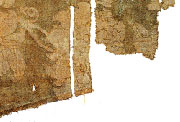 |
 |
|||||||||||||||||
 |
||||||||||||||||||
 |
||||||||||||||||||
| Classified Glossary | ||||||||||||||||||
 |
||||||||||||||||||
 |
||||||||||||||||||
| 43. 1Counted stitch With plain gauze as the ground, counted stitch (nazhen) penetrates the spaces between the warp or weft according to the required length of the stitch. Using the ground weave as a counted grid system, a variety of stitches are employed in this manner resulting in some woven appearances or purely textural effect. When the embroidery covers the gound weave it is called full count embroidery (najin) and partly count embroidery (nasha or chuoshaxiu) when the ground weave uncovered. 44. 1Chinese knot stitch Looping the embroidery thread around the needle while making a stitch is called knot stitch (dazizhen), which appeared first in the Yuan dynasty. There are many types of knot stitches used in Europe as there are in China - some are the same, some are different. 45. 1Outline stitch and border stitch Outline stitch (lunkuozhen) is used to outline of the embroidery piece, while the border stitch (bianzhen) is for the border of a textile piece. Buttonhole stitch (suobianzhen) is a special stitch of border stitch, which was seen in Mongol embroidery. 46. 1Needle-looping An open chain stitch or running stitch is used as the foundation for a series of detached loops to be made. From the initial row of loops many rows of loops are attached by interlooping, sometimes with voided spaces forming pattern. The process is called needle-looping (huanzhenxiu) which originated in Mongol period, popular in the Ming dynasty and rarely seen in the Qing dynasty. |
||||||||||||||||||
| THE BOOK | ||||||||||||||||||
| AUTHOR | ||||||||||||||||||
| CONTENTS | ||||||||||||||||||
| ORDER | ||||||||||||||||||
| CONTACT | ||||||||||||||||||
| LINKS | ||||||||||||||||||